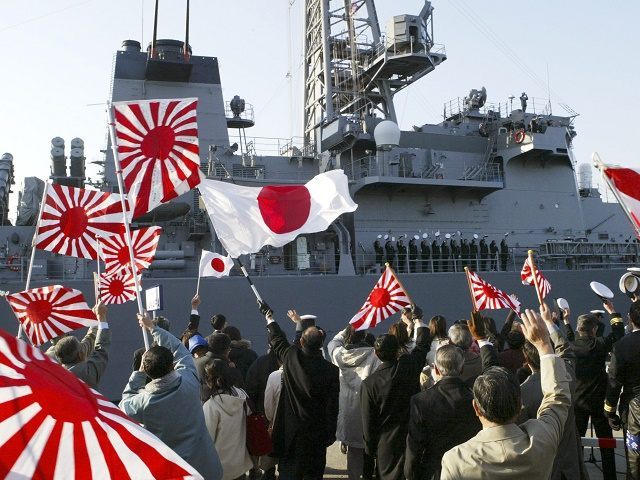This morning’s key headlines from GenerationalDynamics.com
- Japan’s troops in South Sudan become first test of new ‘collective self-defense’ policy
- United Nations warns of mass atrocities in South Sudan
Japan’s troops in South Sudan become first test of new ‘collective self-defense’ policy

Japanese Self-Defense Force soldiers in South Sudan, wearing United Nations blue helmets (Diplomat)
Japan has had peacekeeping troops from its Self-Defense Force (SDF) in South Sudan since 2012, but they were restricted to doing only one kind of thing – rebuilding the country’s infrastructure, such as roads and refugee camps. In particular, they were forbidden from taking part in any military operation of any kind, because Japan’s pacifist constitution, written at the end of World War II, restricts military action to Japanese soil, and then only for self-defense from an invader.
Japan’s prime minister Shinzo Abe has approved a change taking effect on November 20 that will deploy 350 SDF troops to South Sudan and allow them to engage in combat if they are attacked, or if other nations’ peacekeepers are attacked.
This seems to be a relatively mild change in military orders, but in fact it is a major change in policy. Based on campaigning by Shinzo Abe, in 2015 Japan adopted new “collective self-defense” laws, partially departing from the pacifism in the constitution. The old self-defense clause of the constitution has been interpreted to permit military action only when Japan itself is being attacked, and only on Japanese soil. The new collective self-defense laws reinterpret the self-defense clause to include “collective self-defense,” which would permit military action anywhere in the world under some circumstances when an ally (such as the United States) is attacked. I discussed the meaning of “collective self-defense” in detail in 2014 in “5-May-2014 World View — Japan debates ‘collective self-defense’ to protect America and Japan”.
The reinterpretation of the self-defense clause has been extremely divisive in Japan, and at the time it was passed it even resulted in some fists being thrown in the Diet (Japan’s parliament). Abe said that the change was essential for the survival of Japan, while opponents say that approving the exercise of the right to collective self-defensive is a “slippery slope” that will keep expanding to permit additional non-defense military activity.
Opponents of the South Sudan deployment in Japan do indeed view the it as the first step on a slippery slope. According to an editorial in Japan Times:
Possible use of weapons by the SDF troops in rescuing civilians under attack might trigger counterattacks by enemy forces, which could erupt into unexpected fighting. The chance of such developments cannot be ruled out in the extremely fluid security situation in South Sudan. The Abe administration may think that the new mandate, which will be given to the 350 Ground Self-Defense Force personnel to be dispatched there next month, will bring Japan’s peacekeeping mission closer to international standards. But the government should also be aware of, and be accountable for, what it could possibly entail.
Deutsche Welle and Japan Times and Asahi Shimbun (Tokyo) and The Diplomat
Related Articles
- Japan finally adopts ‘collective self-defense’ laws, departing from pacifism (19-Sep-2015)
- Japan debates ‘collective self-defense’ to protect America and Japan (05-May-2014)
- US reaffirms defense of Japan’s Senkaku Islands (28-Apr-2015)
United Nations warns of mass atrocities in South Sudan
U.N. Secretary-General Ban Ki-moon is warning of a “very real risk of mass atrocities” in South Sudan and that peacekeepers deployed in the country will not be able to stop such a bloodbath. According to Ban, “There is a very real risk of mass atrocities being committed in South Sudan, particularly following the sharp rise in hate speech and ethnic incitement in recent weeks.”
The mass atrocities are occurring as a result of renewed ethnic fighting between the Dinka tribe of president Salva Kiir and the Nuer tribe, led by former vice president Riek Machar. Kiir and Machar signed a peace agreement last year in August, but it fell apart several months ago.
The last generational crisis war between the Dinka and Nuer tribes climaxed in 1991 with the “Bor Massacre,” in which hundreds of thousands of Dinkas in the Bor community were starved, displaced or killed by invading Nuer militias led by Machar. Thus, South Sudan is in a generational Awakening era, and there are many survivors of the Bor Massacre from both sides who do not want to see anything so horrible happen again, and will do anything they can to prevent it. So an event similar to the Bor Massacre will not occur, and Ban’s concern about a new full-scale civil war are not realistic.
What we are seeing in South Sudan is a familiar pattern that I have described many times in countries like Syria, Burundi, Thailand, and Zimbabwe, starting 5-15 years after the climax of a generational ethnic crisis war. The leadership in the country, which represents one ethnic tribe or group, decides that in order to prevent a new civil war, it’s necessary to impose “security” by having the security forces commit atrocities against the other ethnic group. AFP
Related Articles
- The African Union proposes an all-African peacekeeping force for South Sudan (20-Jul-2016)
- Fears that renewed South Sudan tribal fighting could spiral into larger war (11-Jul-2016)
- Conflicts grow in South Sudan and Central African Republic (29-Dec-2013)
KEYS: Generational Dynamics, Japan, Shinzo Abe, Self-Defense Force, collective self-defense, South Sudan, Ban Ki-moon, Salva Kiir, Riek Machar, Dinkas, Nuers, Bor Massacre
Permanent web link to this article
Receive daily World View columns by e-mail

COMMENTS
Please let us know if you're having issues with commenting.